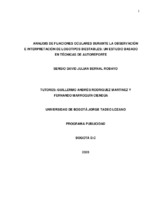Mostrar el registro sencillo del documento
Análisis de fijaciones oculares durante la observación e interpretación de logotipos biestables: un estudio basado en técnicas de autoreporte
| dc.contributor.advisor | Rodríguez Martínez, Guillermo Andrés | |
| dc.contributor.advisor | Marroquín-Ciendúa, Fernando | |
| dc.coverage.spatial | Colombia | spa |
| dc.creator | Bernal Robayo, Sergio David Julián | |
| dc.date.accessioned | 2020-12-07T19:27:09Z | |
| dc.date.available | 2020-12-07T19:27:09Z | |
| dc.date.created | 2020 | |
| dc.identifier.uri | http://hdl.handle.net/20.500.12010/16382 | |
| dc.description.abstract | Identificar las áreas de fijación ocular que están implicadas en la interpretación de los posibles perceptos visuales propios de cuatro logotipos biestables, mediante la aplicación de técnicas de autoreporte. El propósito de identificar esas áreas se concibe para inciar el proceso exploratorio necesario para los procesos de pre-validación de áreas críticas de modulación bottom-up de los identificadores visuales biestables seleccionados. | spa |
| dc.format.extent | 19 páginas | spa |
| dc.format.mimetype | application/pdf | spa |
| dc.language.iso | spa | spa |
| dc.publisher | Universidad de Bogotá Jorge Tadeo Lozano | spa |
| dc.source | instname:Universidad de Bogotá Jorge Tadeo Lozano | spa |
| dc.source | reponame:Expeditio Repositorio Institucional UJTL | spa |
| dc.subject | Publicidad | spa |
| dc.subject | Publicidad -- Tesis y disertaciones académicas | spa |
| dc.title | Análisis de fijaciones oculares durante la observación e interpretación de logotipos biestables: un estudio basado en técnicas de autoreporte | spa |
| dc.type.local | Trabajo de grado de pregrado | spa |
| dc.type.local | Trabajo de grado | spa |
| dc.subject.lemb | Publicidad -- Trabajos de grado | spa |
| dc.subject.lemb | Logotipos | spa |
| dc.subject.lemb | Marcas registradas | spa |
| dc.rights.accessrights | info:eu-repo/semantics/openAccess | spa |
| dc.type.hasversion | info:eu-repo/semantics/acceptedVersion | spa |
| dc.rights.local | Abierto (Texto Completo) | spa |
| dc.identifier.repourl | http://expeditio.utadeo.edu.co | spa |
| dc.creator.degree | Publicista(s) | spa |
| dc.publisher.program | Publicidad | spa |
| dc.relation.references | Baker, D. H., Karapanagiotidis, T., Coggan, D. D., Wailes-Newson, K., & Smallwood, J. (2015). Brain networks underlying bistable perception. NeuroImage, (119), 229- 234. | spa |
| dc.relation.references | Barrera, M., & Calderón, L. (2013). Notes for supporting an epistemological neuropsychology: contributions from three perspectives. International Journal of Psychological Research, 6(2), 107-118. | spa |
| dc.relation.references | Borisyuk, R., Chik, D., & Kazanovich, Y. (2009). Visual perception of ambiguous figures: synchronization based neural models. Biological Cybernetics, (100), 491- 504. | spa |
| dc.relation.references | Brascamp, J., Sterzer, P., Blake, R., & Knapen, T. (2018). Multistable perception and the role of the frontoparietal cortex in perceptual inference. Annual Review of Psychology, 69. 77-103 | spa |
| dc.relation.references | Castelo-Branco, M., & Castelhano, J. (2015). Perceptual decision making. Brain Mapping: An Encyclopedic Refreence, 401-408. | spa |
| dc.relation.references | Coren, S., Ward, L. M., & Enns, J. T. (2001). Sensación y percepción. México, D.F.: McGraw-Hill. | spa |
| dc.relation.references | Cumming, B., & Parker, A. (1997). Responses of primary visual cortical neurons to binocular disparity without depth perception. Nature, 389, 280-283. | spa |
| dc.relation.references | García-Pérez, M. (1989A). Visual inhomogeneity and eye movements in multistable perception. Perception & Psychophysics, 46(4), 397-400 | spa |
| dc.relation.references | Gale, A., & Findlay, J. (1983). Eye-movement patterns in viewing ambiguous figures. In Eye movements and psychological functions: international views (pp. 145-168). Hillsdale NJ: LEA. | spa |
| dc.relation.references | Hsiao, J., Chen, Y., Spence, C., & Yeh, S. (2012). Assessing the effects of audiovisual semantic congruency on the perception of a biestable figure. Consciousness and Cognition, (21), 775-787. | spa |
| dc.relation.references | Hramov, A., Maksimenko, V., Pchelintseva, S., Runnova, A., Grubov, V., Musatov, V., . . . Pisarchik, A. (2017). Classifying the perceptual interpretations of a bistable image using EEG and artificial neural networks. Frontiers in Neuroscience, 11, 674 | spa |
| dc.relation.references | Kanai, C., Carmel, D., Bahrami, B., & Rees, G. (2011). Structural and functional fractionation of right superior parietal cortex in bistable perception. Current Biology, 21(3), R106-R107. | spa |
| dc.relation.references | Kleinschmidt, A., Buchel, C., & Frackowiak, R. (1998). Human brain activity during spontaneously reversing perception of ambiguous figures. Proceedings of the Royal Society of London B: Biological Sciences, 265(1413), 2427-2433. | spa |
| dc.relation.references | Megumi, F., Bahrami, B., Kanai, R., & Rees, G. (2015). Brain activity dynamics in human parietal regions during spontaneous switches in bistable perception. NeuroImage, (107), 190-197 | spa |
| dc.relation.references | Meng, M., & Tong, F. (2004). Can attention selectively bias bistable perception? Differences between binocular rivalry and ambiguous figures. Journal of Vision, (4), 539 - 551. | spa |
| dc.relation.references | Munhall, K., ten Hove, M., Brammer, M., & Paré, M. (2009). Audiovisual integration of speech in a bistable illusion. Current Biology, (19), 735-739. | spa |
| dc.description.abstractenglish | Identify areas of eye fixation that are involved in the interpretation of the possible visual percepts of four bistable logos, through the application of self-reporting techniques. The purpose of identifying these areas is conceived to initiate the necessary exploratory process for the pre-validation processes of critical areas of bottom-up modulation of selected bistable visual identifiers. | spa |
| dc.publisher.faculty | Facultad de Artes y Diseño | spa |
| dc.type.driver | info:eu-repo/semantics/bachelorThesis | spa |
| dc.type.coar | http://purl.org/coar/resource_type/c_7a1f | spa |
Archivos en el documento
Este documento aparece en la(s) siguiente(s) colección(ones)
-
Publicidad [87]

